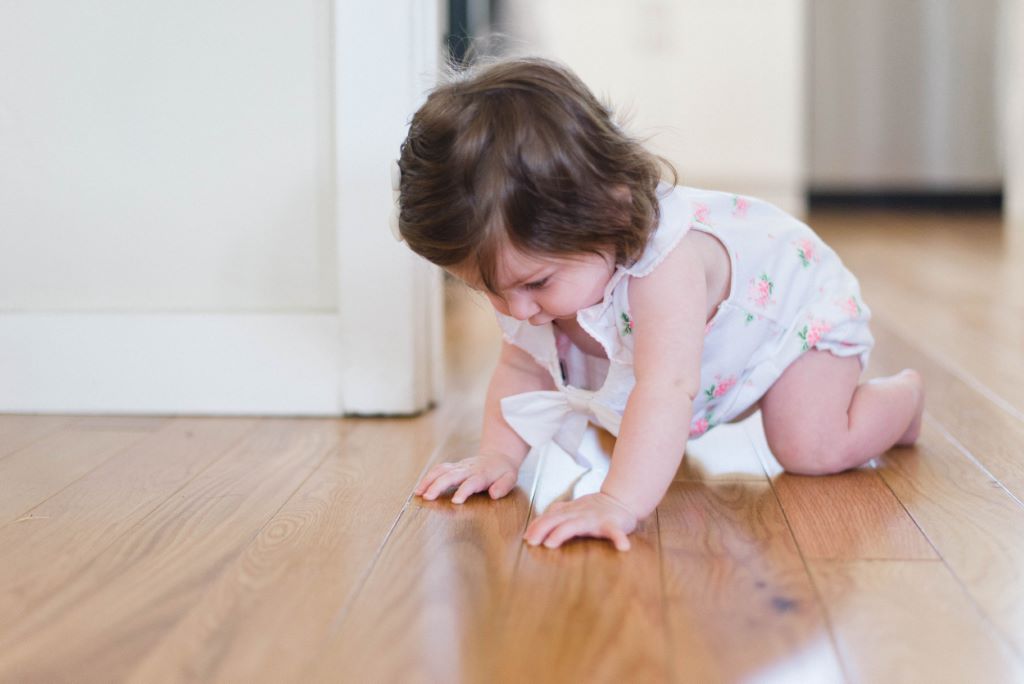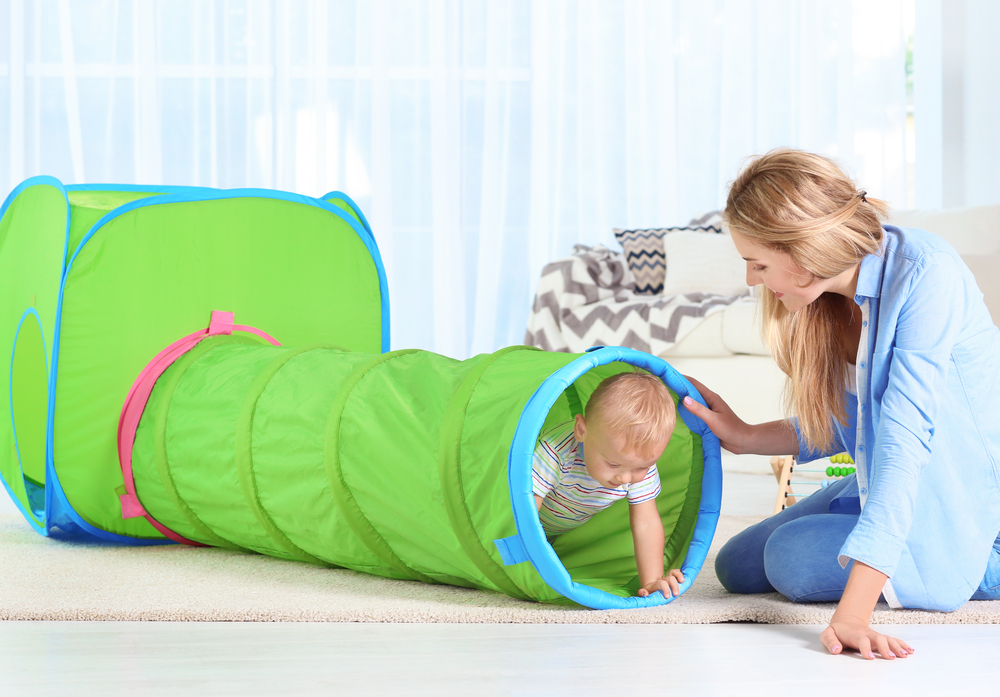For babies, crawling is essential, even critical, for their early development. You probably either know someone or have heard stories of babies who skipped crawling, went straight to walking, and “turned out just fine.” If your baby does skip crawling, they’ll probably be fine. But, as a therapist, I’m here to tell you why it’s important to not skip this milestone as well as what to do if your baby did skip this stage or only briefly crawled on their hands and knees before walking.
Babies will usually begin to crawl when they’re about eight months old. By crawling and interacting with their environment, the baby is rapidly learning. This independent exploration uses all of their senses. While crawling, babies will find toys and other items around the house. They’ll use their fine motor skills to touch, pinch, and pick up the objects they encounter. Simple obstacles will be crawled up and over. In general, they’ll interact with a wide range of sensory items.
Zipping around on their hands and knees will remain the baby’s primary form of mobility for around four to six months, which is when they’ll begin to walk independently. Given the increasing number of babies that skip crawling, going straight to walking, there’s a lot of debate out there about whether or not crawling is a milestone that’s necessary for a child’s development.

Studies have shown that crawling plays a critical role in an infant’s brain development. This cross-lateral movement increases the amount of communication between the two sides of the brain while also strengthening the neural pathways.
A number of cognitive processes can be impacted if a baby skips crawling or doesn’t crawl for a long enough period of time. Some examples of this include not being able to sit up straight, hyperactivity, fidgeting, not being able to hold a pencil correctly, dyslexia, and other learning disabilities.
Crawling could make the difference between holding up a pencil in school or not, being able to use the upper body strength they need to pull themselves up off the floor, and having the lateral movement needed by the brain to be able to read, write, and understand.
Apart from the world of education, learning to crawl before walking offers children a great number of additional benefits.

Crawling favors the growth of neurons, as well as the connections between them. The cross-lateral movement involved in crawling develops and strengthens both hemispheres of the brain at the same time.
Crawling is a complex movement, requiring both sides of the body to work at the same time while carrying out separate motions. This, in turn, means that both sides of the brain must work together, communicating through the corpus callosum, which acts as the brain’s superhighway. This band of fiber connecting the two hemispheres thickens as more cross-lateral movement occurs, thus optimizing communication between the two halves of the brain.
A baby’s early crawl, lacking in coordination and requiring a lot of concentration, will be built upon as the child continues to practice the movements. More crawling will create more connections, building on top of what was built previously. You’ll be able to see this progress as the baby’s movements evolve and become more automatic.
Mastery of crawling—a smooth moment, on hands and knees, hips centered, no swaying, hands not changing places, feet dragging behind them—requires mastering highly coordinated movements. Overcoming any limitations they may have when crawling is a challenge for the baby’s brain.
As they improve and develop their movement, the connections in their brains increase and become more organized. In short, crawling helps babies in the development of complex cognitive processes that will be essential later on for higher-level learning, including memory, focus, concentration, and planning.
Generally, babies should crawl for around six months, if not longer. Educational scientists have found that, in most cases, children with ADHD and other learning disabilities crawled for a relatively short period of time. An immature symmetric tonic neck reflex (STNR) can also be caused by a baby crawling for too little time or skipping crawling altogether. A total of 75% of the learning disabled children and adults in one study had an immature STNR that contributed to their disability.

This STNR is what allows infants to use their upper and lower bodies independently. It’s also behind their urge to crawl, which should go down as they make their way through the crawling phase. By completing the six-month crawling stage, your child will ensure that they have independent control of their arms, legs, and necks. Among the many skills that are necessary to achieve success in learning, integrating the STNR will mean that the child will be able to focus, sit, and learn well.
Over the past decades, clinicians have noted a sharp increase in STNR retention. The fear of putting babies on their tummies due to sudden infant death syndrome (SIDS) along with the invention of baby holders, such as walkers, saucers, and swings, has led to a decrease in tummy time. This, in turn, is leading to crawling lasting for less time or being skipped completely, resulting in STNR retention.
While not all infants who crawl less will face difficulties later on in life, it’s becoming more apparent that an inadequate amount of time spent crawling can be considered a risk factor. This is why it’s a good idea for parents to encourage their babies to crawl. There are simple ways to achieve this, such as putting them on their tummies more often or playing games that involve moving from one spot to another.

From birth on, make sure that your baby gets plenty of tummy time. When playing on their tummies, they’ll develop and strengthen the muscles in their arms, shoulders, torsos, and backs, which will help them learn to crawl later on. For those babies that simply hate tummy time, you can try rolling up a receiving blanket and placing it under their armpits and chest. You can also lay on the floor and place your baby on your chest.
You want to make sure that tummy time is safe, but that doesn’t mean that it can’t be fun! Get down on the floor and play with them. Placing a mirror in front of them is a great way to keep their attention. Get them to move around, helping them to move up and over your legs, pillows, or other obstacles on the floor to get to their favorite toy.
Doing so can be as easy as placing a toy on your lap or on the couch cushions and having them sit on their knees to play with it. You can also hold them by their hips and help them put their weight on their knees.
When your baby is on their hands and knees, put the palms of your hands behind their feet. This will help to stabilize them and give them a base of push off from if they’re learning to crawl.
If you see your baby trying to walk before crawling, try to encourage them to crawl. If you need to, go down to the floor and be their crawling role model. By crawling with them, your child can watch how you lift yourself up using your arms and legs so that they can copy you when ready.
Help your baby when they begin to crawl by giving them chest support. You can even lift them slightly and help them move forward. Have another person in front of the baby engage them with an interesting toy so that they want to move forward and grab it.
Make your baby an obstacle course using soft cushions and pillows that they can climb over. Crawl behind them through the obstacle course to help increase their crawling confidence. You can also buy a crawl tunnel and encourage them to use it by playing with them.
The easiest way for any parent to encourage their child to move around independently and crawl is by getting down on the floor with them to play. Explore, play, and have fun with your baby!

If your baby skipped crawling and went straight to walking—or did so in less than six months—there are still many things you can do to help make sure their STNR is fully integrated along with any other reflexes they may have retained. This will help you make sure your child can tap into their full potential later on in life.
Some of these simple activities, which you can do with your child to encourage them, including playing in tunnels, pretending to be animals that move around the house, having crawl races, playing on the jungle gym at the park, and riding a bike. If your child is older, you can do all of these activities plus more. For example, you can sign your child up for a class, like swimming, where they focus on moving all four limbs in sequence.
To learn more about how you can help your child rise above any learning and behavior difficulties, schedule an individual consultation with me so that I can help you identify the main reasons why your child is struggling with learning, reading, and/or behavior.

Hreyfiland is a family gym that offers play-based movement development classes led by a qualified child motor development therapist.